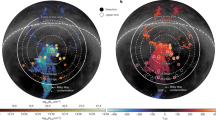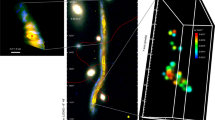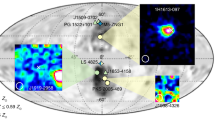Abstract
The high-velocity clouds of atomic hydrogen, discovered about 35 years ago1,2, have velocities inconsistent with simple Galactic rotation models that generally fit the stars and gas in the Milky Way disk. Their origins and role in Galactic evolution remain poorly understood3, largely for lack of information on their distances. The high-velocity clouds might result from gas blown from the Milky Way disk into the halo by supernovae4,5, in which case they would enrich the Galaxy with heavy elements as they fall back onto the disk. Alternatively, they may consist of metal-poor gas—remnants of the era of galaxy formation2,6,7,8, accreted by the Galaxy and reducing its metal abundance. Or they might be truly extragalactic objects in the Local Group of galaxies7,8,9. Here we report a firm distance bracket for a large high-velocity cloud, chain A, which places it in the Milky Way halo (2.5 to 7 kiloparsecs above the Galactic plane), rather than at an extragalactic distance, and constrains its gas mass to between 105 and 2×106 solar masses.
This is a preview of subscription content, access via your institution
Access options
Subscribe to this journal
Receive 51 print issues and online access
$199.00 per year
only $3.90 per issue
Buy this article
- Purchase on Springer Link
- Instant access to full article PDF
Prices may be subject to local taxes which are calculated during checkout




Similar content being viewed by others
References
Muller, C. A., Oort, J. H. & Raimond, E. C.R. Acad. Sci. Paris 257, 1661–1664 (1963).
Oort, J. H. Possible interpretations of the high-velocity clouds. Bull. Astron. Inst. Neth. 18, 421–438 (1966).
Wakker, B. P. & van Woerden, H. High-velocity clouds. Annu. Rev. Astron. Astrophys. 35, 217–266 (1997).
Bregman, J. N. The Galactic Fountain of high-velocity clouds. Astrophys. J. 236, 577–591 (1980).
Houck, J. C. & Bregman, J. N. Low-temperature galactic fountains. Astrophys. J. 352, 506–521 (1990).
Oort, J. H. The formation of galaxies and the origin of the high-velocity hydrogen clouds. Astron. Astrophys. 7, 381–404 (1970).
Blitz, L., Spergel, D. N., Teuben, P. J., Hartmann, L. & Burton, W. B. High-velocity clouds: Remnants of Local Group formation. Bull. Am. Astron. Soc. 28, 1349 (1996).
Blitz, L., Spergel, D. N., Teuben, P. J., Hartmann, L. & Burton, W. B. High-velocity clouds: Building blocks of the Local Group. Astrophys. J. 514, 818–843 (1999).
Kerr, F. J. & Sullivan, W. T. The high-velocity hydrogen clouds considered as satellites of the Galaxy. Astrophys. J. 158, 115–122 (1969).
Verschuur, G. L. High-velocity neutral hydrogen. Annu. Rev. Astron. Astrophys. 13, 257–293 (1975).
Schwarz, U. J., Wakker, B. P. & van Woerden, H. Distance and metallicity limits of high-velocity clouds. Astron. Astrophys. 302, 364–381 (1995).
Danly, L., Albert, C. E. & Kuntz, K. D. Adetermination of the distance to the high-velocity cloud complex M. Astrophys. J. 416, L29–L31 (1993).
Ryans, R. S. I., Keenan, F. P., Sembach, K. R. & Davies, R. D. The distance to Complex M and the Intermediate Velocity Arch. Mon. Not. R. Astron. Soc. 289, 83–96 (1997).
Bates, B., Catney, M. G. & Keenan, F. P. High-velocity gas components towards 4 Lac. Mon. Not. R. Astron. Soc. 242, 267–270 (1990).
Stoppelenburg, P. S., Schwarz, U. J. & van Woerden, H. Westerbork HI observations of two high-velocity clouds. Astron. Astrophys. 338, 200–208 (1998).
Danly, L., Lockman, F. J., Meade, M. R. & Savage, B. D. Ultraviolet and radio observations of Milky Way halo gas. Astrophys. J. Suppl. Ser. 81, 125–161 (1992).
de Boer, K. S. et al. The distance to the Complex C of high-velocity halo clouds. Astron. Astrophys. 286, 925–934 (1994).
Van Woerden, H., Peletier, R. F., Schwarz, U. J., Wakker, B. P. & Kalberla, P. M. W. in Stromlo Workshop on High-Velocity Clouds (eds Gibson, B. K. &Putman, M. E.) 1–25 (ASP Conf. Ser. 166, Astron. Soc. Pacif, San Francisco, (1999).
Tamanaha, C. M. Distance constraints to the AntiCenter high-velocity clouds. Astrophys. J. Suppl. Ser. 104, 81–100 (1996).
Wakker, B. P., van Woerden, H., de Boer, K. S. & Kalberla, P. M. W. Alower limit to the distance of HVC complex H. Astrophys. J. 493, 762–774 (1998).
Wakker, B. P. & van Woerden, H. Distribution and origin of high-velocity clouds. III. Clouds, complexes and populations. Astron. Astrophys. 250, 509–532 (1991).
Wakker, B. P. et al. The distance to two hydrogen clouds: the high-velocity complex A and the low-latitude intermediate-velocity arch. Astrophys. J. 473, 834–848 (1996).
Adelman, S. J., Fisher, W. A. & Hill, G. An atlas of the field horizontal branch stars HD 64488, HD 109995 and HD 161817 in the photographic region. Publ. Dominion Astrophys. Obs. Victoria 16, 203–280 (1987).
Wakker, B. P., Murphy, E. M., van Woerden, H. & Dame, T. M. Asensitive search for molecular gas in high-velocity clouds. Astrophys. J. 488, 216–223 (1997).
Tufte, S. L., Reynolds, R. J. & Haffner, L. M. WHAM observations of Hα emission from high-velocity clouds in the M, A, and C complexes. Astrophys. J. 504, 773–784 (1998).
Verschuur, G. L. An association between HI concentrations within high-velocity clouds A and C and nearby molecular clouds. Astrophys. J. 361, 497–510 (1990).
Meyerdierks, H. Acloud-Galaxy collision: observation and theory. Astron. Astrophys. 251, 269–275 (1991).
Verschuur, G. L. The high-velocity cloud complexes as extragalactic objects in the Local Group. Astrophys. J. 156, 771–777 (1969).
Oort, J. H. in Problems of Physics and the Evolution of the Universe (ed. Mirzoyan, L.) 259–280 (Acad. Sci. of Armenian SSR, Yerevan, (1978).
Wakker, B. P. & Schwarz, U. J. Westerbork observations of high-velocity clouds. Discussion. Astron. Astrophys. 250, 484–498 (1991).
Benjamin, R. A. & Danly, L. High-velocity rain: The terminal velocity model of Galactic infall. Astrophys. J. 481, 764–774 (1997).
Adelman, S. J. Elemental abundance analyses with coadded DAO spectrograms–IV. Revision of previous analyses. Mon. Not. R. Astron. Soc. 235, 749–762 (1988).
Chaboyer, B., Demarque, P., Kernan, P. J. & Krauss, L. M. The age of globular clusters in light of Hipparcos: resolving the age problem? Astrophys. J. 494, 96–110 (1998).
Fernley, J. et al. The absolute magnitudes of RR Lyraes from HIPPARCOS parallaxes and proper motions. Astron. Astrophys. 330, 515–520 (1998).
Lucke, P. B. The distribution of color excesses and interstellar reddening material in the solar neighborhood. Astron. Astrophys. 64, 367–372 (1978).
Hoffmeister, C. Neuer RR Lyrae-Stern S5218 Ursae Majoris. Astron. Nachrichten 284, 165–166 (1958).
Acknowledgements
The William Herschel Telescope (WHT) is operated by the Royal Greenwich Observatory, in the Observatorio del Roque de los Muchachos of the Instituto de Astrofisica de Canarias, with financial support from PPARC (UK) and NWO (NL). We thank the NFRA La Palma Programme Committee, and in particular H. Henrichs, for their support for our programme. The Effelsberg Telescope belongs to the Max Planck Institute for Radio Astronomy in Bonn. B.P.W. was partly supported by NASA through STScI, which is operated by AURA, Inc, and also thanks B. Savage for financial support and useful discussions.
Author information
Authors and Affiliations
Corresponding author
Rights and permissions
About this article
Cite this article
van Woerden, H., Schwarz, U., Peletier, R. et al. A confirmed location in the Galactic halo for the high-velocity cloud ‘chain A’. Nature 400, 138–141 (1999). https://doi.org/10.1038/22061
Received:
Accepted:
Issue Date:
DOI: https://doi.org/10.1038/22061
Comments
By submitting a comment you agree to abide by our Terms and Community Guidelines. If you find something abusive or that does not comply with our terms or guidelines please flag it as inappropriate.



